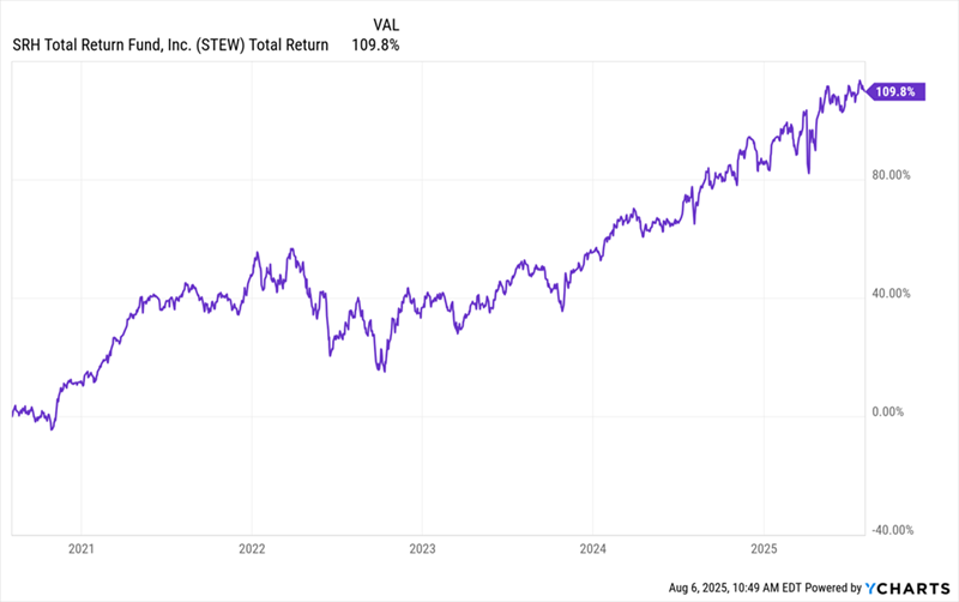When it comes to a closed-end fund (CEF), many investors are always focused on one thing: the dividend.
It makes sense: CEFs pay 8.5% yields, on average, according to data from my CEF Insider service.
But sometimes it pays to look beyond those big payouts, because by doing so, you could find a CEF with a track record so strong that its total return (dividends and gains combined) beats that of a CEF with a high yield.
I don’t know about you, but I’m willing to take more of my return in the form of price gains if it means, say, doubling my money in five years!
This CEF Winner Is Hiding Behind Its “Low” Payout
That’s been the case with the SRH Total Return Fund (STEW), whose dividend—at 3.8%—is pretty, well, meh, for a CEF. As a result, it’s often overlooked, which is what’s happening now. We can see that in the fund’s discount to net asset value (NAV, or the value of its underlying portfolio), which is just under 20% today (more on this shortly).
That ridiculous discount is an insult to this proven fund, which has doubled an investor’s money, with dividends reinvested, in the last half-decade.
That’s a fantastic return by any measure. It even beat the S&P 500, which is up around 103% since then. The funny thing is, the strategy behind this money-making fund is simple, which is why its bargain valuation is so surprising.
Inspired by Warren Buffett, STEW uses a value-investing approach that makes the fund less volatile than the broader market while helping it rise in value over the long haul.
Its largest investment is in Berkshire Hathaway (BRK.A, BRK.B), which is about 45% of the fund’s assets. Additionally, STEW looks for valuable underpriced stocks, which is why it also holds JPMorgan Chase & Co. (JPM), pipeline operator Enterprise Products Partners (EPD), Microsoft (MSFT) and other high-quality firms with long histories of returning cash to shareholders through dividends and stock buybacks.
This is all good stuff, but now let me show you the best part: that bargain valuation I mentioned a second ago.
This is where a big difference between CEFs and ETFs comes in: ETFs can issue shares as necessary, so they don’t trade at discounts (or at least significant ones). But STEW, as a CEF, has a fixed number of shares (hence the “closed” in the term “closed-end fund”). As a result, a CEF’s shares can trade up or down depending on market demand, in addition to their movements on the value of the fund’s assets.
That, in turn, means CEFs can sometimes trade well below NAV. And STEW’s discount, as I mentioned a second ago, is truly massive: just under 20%!
Note that this markdown was even wider in recent months. In fact, STEW’s discount has slowly grown larger over the last five years despite the fact that the fund beat the market. This inefficiency can’t last, which is why STEW’s discount suddenly shrank in recent weeks. Its discount is likely to shrink further as more investors catch on.
All of this might sound familiar if you’ve been reading my articles for a while, because in a March 31, 2025, piece, I pointed out that STEW’s massive (then 23.1%) discount was unlikely to last. It has shrunk a bit since then, and I see it shrinking more.
Now, let me wheel back to the dividend part of the picture here. To be sure, that 3.8% payout is, as mentioned, on the small side for a CEF. But it’s also masking something else, besides STEW’s strong total return: dividend growth.
That too has been strong, with the payout soaring 62% in the last five years. And lately, STEW’s payout growth has been accelerating:
It’s just another reason why with CEFs (or any income investment, really), it pays to look beyond the yield. STEW, with its discount, performance history and growing payout, is a perfect example of that.
Michael Foster is the Lead Research Analyst for Contrarian Outlook. For more great income ideas, click here for our latest report “Indestructible Income: 5 Bargain Funds with Steady 10% Dividends.”
Disclosure: none

